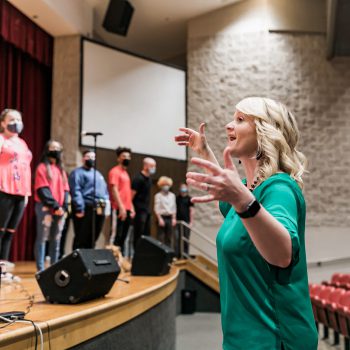Make Notes: CMCSS Choir Teacher Sings Above the Noise of the Pandemic
May 4, 2021


In 2020, amid a world of physical distancing, the simple joy of a chorus of voices seemed at risk. Thankfully, related arts teachers are known for their out-of-the-box thinking, and they refused to let a pandemic stop the music.
Kristina Waugh, the choral director at Rossview High school, has persevered through this school year, finding innovative ways to encourage students and fellow educators. It didn’t always seem possible.
Ms. Waugh reflected on the pace of information through the summer, “No one knew the weight of everything.” As teachers searched to see what would and could be possible for their students, there were no clear answers. It wasn’t until a choir practice in Washington state revealed the realization that singing was not safe.
At that moment, Ms. Waugh, a music teacher for the past 15 years, knew this year would be dramatically different. “It was heartbreaking at first to know we may not be able to sing,” she said.
The thought of losing their voice and limiting their ability to create with the students was overwhelming. “It was really scary,” she said. “We do what we do because we love creating art. It’s a living, breathing thing. We had to come together to figure out how we could still be creating music.”
Later in the summer, the University of Colorado released a study on how music can be done safely. The research gave teachers hope that something would be possible. “Here’s how we can do this, and we can do it safely,” said Ms. Waugh. “Music is possible. There are just guidelines we have to follow.”
As districts across the nation remained closed, CMCSS reopened, bringing students back into the music room. In a typical year, music is a more interactive and physical process. Students may stand in a circle while they move and adjust their bodies to adapt to a song. This year, none of that was possible.

The class did a lot of body percussion, creating rhythms with their hands and body. “I started with some of this as we were gradually figuring out how to sing safely,” she said. At that time, the group performed “White Winter Hymnal,” made famous by the Pentatonix. “I recorded the choir and then added the audio to a video of them performing the body percussion. Therefore, they were not singing when seated less than 6-feet apart.”
“With our standards, performance is a huge part of our time,” Ms. Waugh said. While performance was limited, it propelled another equally important standard to the forefront. “This year, we have really been able to develop another standard, connecting. We’ve had so many more conversations about what the music means. Ultimately developing what makes the music so much stronger.”
As the students began to dig deeper into the music, they discovered that there was so much more to the songs. “We’ve dug into the composer, the history, the lyrics. The students are connecting to the music. They’re finding symbolism in the song.”
The relationship between teacher and student continues to develop as well. For one project, Ms. Waugh asked the students to send in the music they enjoyed rather than what was normally assigned. “It was a great experience to learn more about my students and their interests.”
In a traditional year, the choir includes an average of 130 students. This year, Ms. Waugh has 85 traditional students and 30 virtual students. In an average year, the choir will hold several choral performances and participate in community and regional events. In-person events have been limited, and the restrictions surrounding licensing and synchronization online make virtual concerts a struggle.
For now, Ms. Waugh reflects on one of the most significant growth opportunities for her students. “We have learned our time together is so valuable.”
Throughout the year, she has made sure her students know she’s there to support them. “In January and February, there were moments where I had to stop [class] and just say, ‘How are you guys doing?’ For some kids, the reason they come to school is music class. This is where they feel they belong.”
The connection with her peers took effort as well. While most teachers work within the school building on a grade-level team, the related art teachers are limited.
This required an active commitment to connecting. Impromptu check-ins began during the summer and carried through the school year. The human connection made a huge impact on many of the teachers.
“Over the summer, there were many times we connected with each other just to talk it out. We have to let each other know it’s okay. We’re right there with you.”
Around Winter Break, the teachers gathered again to work through struggles and find solutions together. “It’s really helpful to hear you’re not alone,” she said.
This spring, she has planned a concert with the theme of “Rise Up.” It will feature some inspirational songs about how everyone has had to rise up over the past year.
This encouragement of both students and fellow educators earned her a nomination for a CMCSS Bright Spot.
“I try to stay positive,” she explained. But then admitted, “It’s not always easy.” For her, it was having the courage and the commitment to step out of the norm. “The hard thing about what [teachers] do is we often try to ‘stay in our lane.’ But, take that extra second and send an email. Recognize what someone is doing. Those are huge pick-me-ups. We all need someone to pat us on the back or give an encouraging message.”
She also reflected ultimately on the importance of self-care. “You cannot stress enough the importance of mental health. Get outside and get fresh air. Our jobs will demand as much as you give it. But you must carve out that time to replenish yourself.” Everyone has responsibilities in all areas of their lives, but “we can only be successful if we replenish ourselves.”
https://www.youtube.com/watch?v=XNrSKHXKi4o
